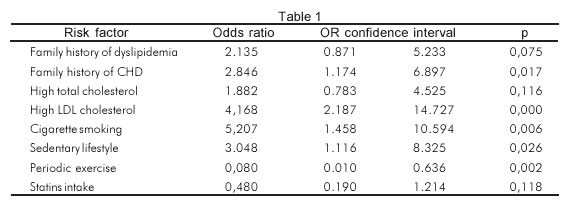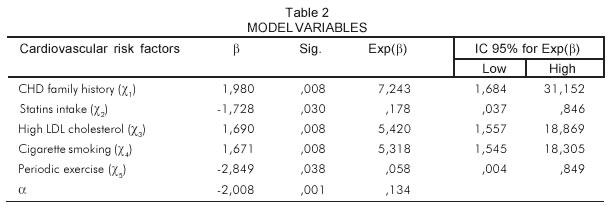Services on Demand
Journal
Article
Indicators
 Cited by SciELO
Cited by SciELO  Access statistics
Access statistics
Related links
 Cited by Google
Cited by Google  Similars in
SciELO
Similars in
SciELO  Similars in Google
Similars in Google
Share
Revista Colombiana de Cardiología
Print version ISSN 0120-5633
Abstract
FRANCO, Gloria; JARAMILLO, Samuel; DE FEX, José Victor and SIERRA, Lina M. Predictive model of high calcium score in patients with cardiovascular risk factors. Rev. Col. Cardiol. [online]. 2007, vol.14, n.6, pp.359-368. ISSN 0120-5633.
Introduction: it has been found through multiple studies that coronary calcium score is a good predictor of coronary disease in asymptomatic individuals with one or more cardiovascular risk factors; therefore it would be ideal to perform this test in order to stratify its risk, but due to economic factors this is not possible in most cases. The model presented allows predicting the probability that a patient may have a high coronary calcium score by means of his cardiovascular risk factors. The originality of the model is that it also comprises "protector" factors that diminish such probability. Methods: study of cases and controls in asymptomatic patients with cardiovascular risk factors to whom a PCC had been performed. The cases are patients with coronary calcium score greater than percentile 75 for his age and gender; the control case relationship is 2:1. Results: ages ranged between 35 and 75 years; 14.4% were female; 44.4% had family history of CHD; 34.4% were hypertensive; 38.9% had high total cholesterol; 24.4% had HDL cholesterol under 40 mg/dl; 33.3% had LDL cholesterol greater than 160 mg/dl; 25.6% were cigarette smokers; 23.3% were sedentary; 13.3% were periodical alcohol consumers; 15.6% were obese (BMI > 30); 18.9% exercised periodically and 34.4% received statins. Cardiovascular risk factors correlated with high coronary calcium score are recorded in table 1.  In the logistic regression model, factors having a p < 0.15 value are included, bearing in mind that for the sample size, up to eight variables can be included; after realizing the Cox regression, results observed in table 2 are obtained.
In the logistic regression model, factors having a p < 0.15 value are included, bearing in mind that for the sample size, up to eight variables can be included; after realizing the Cox regression, results observed in table 2 are obtained.  Expression for the model would be:
Expression for the model would be:  The values of ci values are 1, if the factor is present and 0 if it is not. Conclusions: this model does not pretend to replace stratification through Framinghan model; on the contrary, it is a complement that allows the physician to realize if the coronary calcium score test is recommended for patients with cardiovascular risk factors. It can be observed that many risk factors that are correlated with a high coronary calcium score value can be modified: stop smoking or doing physical exercise.
The values of ci values are 1, if the factor is present and 0 if it is not. Conclusions: this model does not pretend to replace stratification through Framinghan model; on the contrary, it is a complement that allows the physician to realize if the coronary calcium score test is recommended for patients with cardiovascular risk factors. It can be observed that many risk factors that are correlated with a high coronary calcium score value can be modified: stop smoking or doing physical exercise.
Keywords : cardiovascular risk; calcium score; computed tomography with multidetectrors.














